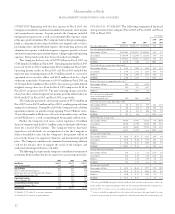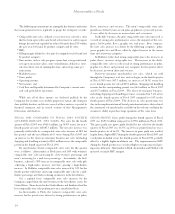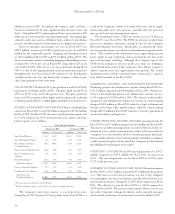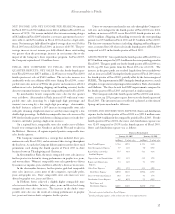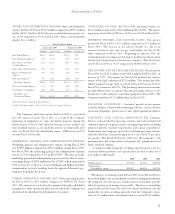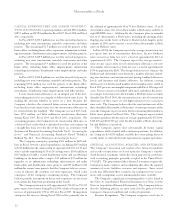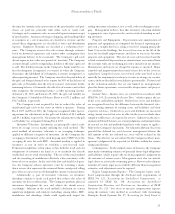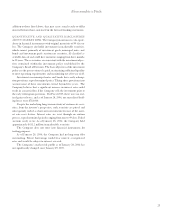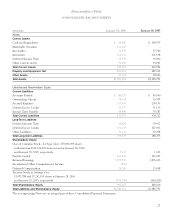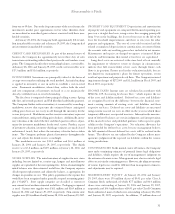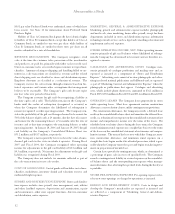Abercrombie & Fitch 2005 Annual Report Download - page 24
Download and view the complete annual report
Please find page 24 of the 2005 Abercrombie & Fitch annual report below. You can navigate through the pages in the report by either clicking on the pages listed below, or by using the keyword search tool below to find specific information within the annual report.
Abercrombie &Fitch
CAPITAL EXPENDITURES AND LESSOR CONSTRUC-
TION ALLOWANCES Capital expenditures totaled $256.4 million,
$185.1 million and $159.8 million for Fiscal 2005, Fiscal 2004 and Fiscal
2003, respectively.
In Fiscal 2005, $204.7 million was used for store related projects,
including new store construction, remodels, conversions and other
projects. The remaining $51.7 million was used for projects at the
home office, including home office expansion, information technol-
ogy investments, distribution center improvements and other projects.
In Fiscal 2004, $169.7 million was used for store related projects,
including new store construction, remodels, conversions and other
projects. The remaining $15.4 million was used for projects at the
home office, including home office improvements, information
technology investments, distribution center improvements and other
projects.
In Fiscal 2003, $124.8 million was used for store related projects,
including new store construction, remodels and other projects. The
remaining $35.0 million was used for projects at the home office,
including home office improvements, information technology
investments, distribution center improvements and other projects.
Lessor construction allowances are an integral part of the deci-
sion making process for assessing the viability of new store leases. In
making the decision whether to invest in a store location, the
Company calculates the estimated future return on its investment
based on the cost of construction, less any construction allowances to
be received from the landlord. The Company received $42.3 mil-
lion, $55.0 million and $60.6 million in construction allowances
during Fiscal 2005, Fiscal 2004 and Fiscal 2003, respectively. For
accounting purposes, the Company treats construction allowances as
a deferred lease credit which is amortized to reduce rent expense on
a straight-line basis over the life of the leases in accordance with
Statement of Financial Accounting Standards No.13, “Accounting for
Leases” and Financial Accounting Standards Board Technical
Bulletin No. 88-1, “Issues Relating to Accounting for Leases.”
The Company anticipates spending $400 million to $420 mil-
lion in Fiscal 2006 for capital expenditures, including $205 million
to $210 million for the construction of approximately 100 to 110 new
stores and the remodeling of 10 to 20 existing stores; $100 million to
$105 million to build a second distribution center and an additional
building on the home office campus; $40 million to $45 million for
upgrades to its information technology infrastructure and other
home office and distribution center projects; and $55 million to $60
million for various store projects that the Company believes are nec-
essary to enhance the customer’s in-store experience, which is the
centerpiece of the Company’s marketing strategy. The Company
believes periodic investments in the in-store experience are necessary
to maintain the long-term positioning of the brands.
The Company intends to add approximately 700,000 to 750,000
gross square feet of stores during Fiscal 2006, which will represent an
increase of approximately 10% to 12% over Fiscal 2005. Management
anticipates the increase during Fiscal 2006 will be primarily due to
the addition of approximately 60 to 70 new Hollister stores, 15 to 20
abercrombie stores, five to ten Abercrombie & Fitch stores and five to
eight RUEHL stores. Additionally, the Company plans to remodel
five to 15 Abercrombie & Fitch stores, including the opening of the
flagship store in the Grove at Farmer’s Market in Los Angeles in the
summer of 2006 and to convert a total of four Abercrombie & Fitch
stores to Hollister stores.
In Fiscal 2006, the Company expects the average construction cost
per square foot, net of construction allowances, for new Hollister
stores to increase from last year’s actual of approximately $114 to
approximately $130. The Company expects the average construc-
tion cost per square foot, net of construction allowances, for new
abercrombie stores to increase from last year’s actual of approximately
$154 to approximately $169. The change from last year’s estimates for
Hollister and abercrombie were driven by a number of factors, includ-
ing store location, construction material pricing, landlord allowance
levels, and furniture and fixture additions. In addition, varying
allowance levels for the small number of abercrombie stores added in
Fiscal 2005 prevent a meaningful comparison with Fiscal 2006 expected
costs. Due to variances in landlord allowances and other characteris-
tics unique to the three new Abercrombie & Fitch locations currently
identified for Fiscal 2006, the construction costs, net of construction
allowances, of these stores are also higher than last year’s actual per
store costs. The Company believes that the construction costs of the
three identified Abercrombie & Fitch stores are not representative of the
costs the Company expects to incur for the remaining Abercrombie &
Fitch stores planned in Fiscal 2006. The Company expects initial
inventory purchases for the stores to average approximately $371,000,
$148,000 and $243,000 per store for Abercrombie & Fitch, abercrom-
bie and Hollister, respectively.
The Company expects that substantially all future capital
expenditures will be funded with cash from operations. In addition,
the Company has $250 million available (less outstanding letters of
credit) under its Amended Credit Agreement to support operations.
CRITICAL ACCOUNTING POLICIES AND ESTIMATES
The Company’s discussion and analysis of its financial condition
and results of operations are based upon the Company’s consoli-
dated financial statements, which have been prepared in accordance
with accounting principles generally accepted in the United States
(“GAAP”). The preparation of these financial statements requires the
Company to make estimates and assumptions that affect the reported
amounts of assets, liabilities, revenues and expenses. Since actual
results may differ from those estimates, the Company revises its esti-
mates and assumptions as new information becomes available.
The Company’s significant accounting policies can be found in
the Notes to Consolidated Financial Statements (see Note 2 of the
Notes to Consolidated Financial Statements). The Company believes
that the following policies are most critical to the portrayal of the
Company’s financial condition and results of operations.
Revenue Recognition - The Company recognizes retail sales at
22


